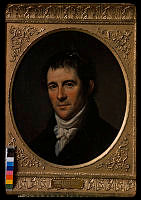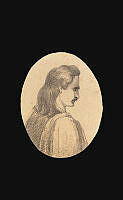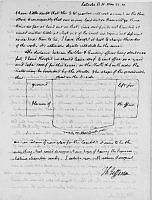Rubenstein Center Scholarship
The Mysterious Life of Susan Decatur
In his 1872 recollection Our Neighbors on Lafayette Square, Benjamin Ogle Tayloe reminisced about the residents of the square just north of the White House. He wrote, “Mrs. Decatur was the natural born daughter of Mr. Wheeler, an eminent merchant of Norfolk, and the proprietor of ironworks at Elk Ridge Landing, Maryland, where Mrs. Decatur was born, her mother an obscure woman of that place.”1 Like many women in early America, Susan Wheeler Decatur and her mother’s stories are overshadowed by the men around them. Yet, Susan ultimately became a prominent figure in Washington, Baltimore, and Norfolk. Although it has proved challenging to find more information about her life, this article seeks to tell Susan Wheeler Decatur’s story.

Susan Decatur
Painting on loan from Priscilla Machold Loeb and FamilySusan’s story begins with her father, Luke Wheeler. Luke was born in 1754 in Prince George’s County, Maryland. Evidence suggests that he moved throughout Maryland frequently until eventually settling in Norfolk, Virginia, around 1797.2 According to a Dorchester County Court land record, one Luke Wheeler married a woman named Lilly Loockerman on November 28, 1778.3 Susan was born between 1776 and 1778 near Elk Ridge Landing. Although the land record provides some insight into one Luke Wheeler’s life, a birth record for Susan has not been found. As such, the identity of Susan’s mother remains unclear.4 It is, however, evident that Susan grew up in Maryland where she attended a Baltimore academy for young women and met her best friend Catharine “Kitty” Carroll. Kitty Carroll was the daughter of Charles Carroll, the only Catholic signer of the Declaration of Independence.5
By 1797, Luke Wheeler moved to Norfolk and Susan likely moved with him.6 After 1803, however, there is no mention of Lilly Loockerman Wheeler in any documentation. Her omission from the archival record, along with her omission from Susan’s surviving documents, likely led to speculation about her identity by their contemporaries.7 This is the most that can currently be said about Lilly. It is unclear when she died, and she is not mentioned in Susan’s surviving personal correspondence. As such, it remains unclear if Lilly Loockerman was truly her mother. Much more is known about Luke Wheeler, however, as he became a prominent figure and in 1805 was elected mayor of Norfolk.

Map of Virginia and Maryland
Library of CongressIn November 1805, Susan met her future husband, Stephen Decatur, when he was in Norfolk escorting Tunisian Ambassador Soliman Melimeni during his visit to the United States.8 Stephen Decatur was a well-known American naval war hero, who rose to prominence during the Barbary Wars and was promoted to the rank of captain. Decatur became the youngest man in United States history to earn the rank at twenty-five years old.9 Today, he remains the youngest man to hold that distinction. On March 8, 1806, Susan and Stephen were married at her father’s home in Norfolk by a Presbyterian minister.10
After their wedding, Stephen’s naval career led to several relocations. In 1806, the couple traveled along the East Coast reporting for Stephen’s assignments.11 The 1810 census lists the couple in Norfolk, along with five enslaved individuals recorded in their household.12 On the same census, Luke Wheeler’s household also lists five enslaved persons.13 While little else is known about the Decaturs’ relationship with slavery before their move to Washington D.C., this finding reveals that they likely relied on enslaved labor. The question remains whether the individuals were owned or rented out by the family.
At the outbreak of the War of 1812, Stephen was promoted to commodore, the highest rank in the navy at that time. He received national attention when he became the first American to capture a British frigate, the HMS Macedonian, and bring it safely into harbor in Newport, Rhode Island. For his heroic actions, Congress awarded Stephen a gold medal and $30,000 in prize money.14 Around 1818, Stephen purchased a significant amount of land on President’s Square (known today as Lafayette Square) and built a home with the prize money. In 1819, Susan and Stephen moved into their home across the square from the White House.

Commodore Stephen Decatur
The White House Historical Association and Decatur House, a National Trust SiteLiving at Decatur House, Susan was in the center of Washington society. This brought close friendships and excitement, but also meant her life was very public. Susan and Stephen entertained many of Washington’s prominent political and military figures along with their families. On March 21, 1820, the couple attended a party at Secretary of State John Quincy Adams’ home for a celebration of President James Monroe’s daughter, Maria Monroe’s, marriage to Samuel Gouverneur.15 The next morning, Stephen traveled to Bladensburg, Maryland, to duel Commodore James Barron. Both men were shot, and Barron survived. Stephen, however, was brought back to Decatur House. Susan was shocked, as Stephen had left that morning without telling her of his plans. She and her father, Luke, were at the home when the men brought Stephen into the parlor. Stephen died in the first floor parlor between nine and ten that same evening.16 Understandably Susan was devastated and unprepared for his death.17
In his last will and testament, Stephen left his entire estate to Susan; the couple had no children. He also named three men – Littleton Waller Tazewell of Norfolk, Robert G. Harper of Baltimore and Kitty Carroll Harper’s husband, and Colonel George Bomford of Washington as executors of his estate.18 Stephen’s will indicates that he did not own enslaved persons at the time of his death, and there are no known records of enslaved persons living with the couple at Decatur House.
After Stephen’s death, Susan secluded herself from public life. She mourned at Decatur House, and in April, her best friend Catharine “Kitty” Carroll Harper took Susan to Doughoregan Manor in Maryland to grieve.19 The two stayed with Kitty’s father, Charles Carroll. In a letter between Carroll and his son-in-law Robert Goodloe Harper, Kitty’s husband, Carroll writes, “I think the exercise and change of scene has greatly benefited Mrs. Decatur; her spirits are more composed, she dines with us, and converses more…”20
Susan spent several months in Maryland and returned to Washington later that year. When she moved back to the city, she lived in Kalorama near Stephen’s first resting place. While Susan was away, she had the executors of Stephen’s will auction off many of her belongings at Decatur House. She did, however, keep the house and most of the property on Lafayette Square. Susan then moved to a cottage near Georgetown University in late 1820. As owner of Decatur House, Susan began renovations to the home, which she planned to rent out.21The Decatur House renovations and upkeep proved to be an expensive and time-consuming undertaking. While the Decaturs’ status in Washington society indicated moderate wealth, further research revealed that Susan’s financial situation was more complicated.22

Decatur House
The White House Historical Association and Decatur House, a National Trust SiteAt the time of Stephen’s death, their wealth was likely tied up in the house and the adjoining properties. The Decaturs moved into their home on Lafayette Square around the time of the Panic of 1819. The financial crisis depressed land values throughout the country, impacting trade and currency. Although documents detailing the value of Decatur House in 1820 have not been found, it is likely that the Decaturs, like the rest of the country, were impacted by plummeting property values. Additionally, while Susan still had regular bills to pay, like property taxes, she no longer had reliable income from Stephen’s salary as a member of the Board of Naval Commissioners.23
On October 28, 1820, Luke Wheeler wrote on Susan’s behalf to Robert Oliver, asking for a $3,000 mortgage of Decatur House and her property on Lafayette Square. Oliver agreed. Susan asked Oliver for money three times in less than two years. Between November 1820 and June 1822, he loaned Susan a total of $23,000.24 With these funds Susan paid for insurance premiums, renovations of the house, and to fill lots in the square. Many of the renovations to Decatur House were made for the French ambassador, Jean-Guillaume, the baron Hyde de Neuville, and included building a servants’ quarters for wage laborers and enslaved persons that renters brought with them.25 Susan rented out Decatur House to foreign ambassadors and American politicians for fifteen years.26
Despite this rental income, Susan’s financial problems worsened. In 1825, attempting to remedy her problems, Susan petitioned Congress for Stephen’s naval pension.27 There was significant debate, as Stephen did not die in the line of duty, but rather in a duel with another naval officer. The petition, however, received support from prominent politicians, including former President John Quincy Adams.
Susan spent the rest of her life in her rented cottage near Georgetown University. She became very involved with the campus community and church and even converted to Catholicism. On November 25, 1828, she was baptized in Holy Trinity Church, the Catholic church at Georgetown, and received first communion on December 31, 1828, reflecting both her relationship with the university community and her friend Kitty Carroll Harper, who was raised a devout Catholic.28
The rental income Susan received from Decatur House allowed her to pay back the principal on her loans from Oliver, however, she continued to struggle with her finances, unable to pay the remaining interest.29 By 1836, Susan could no longer afford to own and maintain Decatur House. She sold the home to John Gadsby, owner of the National Hotel, who also profited from buying and selling enslaved people in D.C.
As part of her pension petition, she also lobbied Congress to receive prize money Stephen should have earned for capturing and burning the frigate USS Philadelphia in 1804 during the Barbary Wars. Susan pursued the money for many years and was eventually awarded the pension and payments in arrears in 1837.30 Although Susan still experienced financial struggles, she gave $7,000 to Georgetown University after receiving the pension money. In exchange she received monthly annuity payments from the university. Despite Susan’s donation, Georgetown still experienced financial instability. The following year, The Society of Jesus sold 272 enslaved men, women, and children to save Georgetown from bankruptcy.31 Given her financial state, it seems odd that Susan would have donated $7,000 to the university. She likely made the donation because of her proximity to the school and her friendships with the clergy, faculty, and students. This strong connection between Susan and the Georgetown community is further supported by accounts stating that Susan hosted dinners for faculty and students at her home.

This 1860 Slave Schedule shows that Susan owned an enslaved infant.
Ancestry.comThe 1860 slave schedule, taken only a month before Susan’s death, reveals that she owned an enslaved female infant. It is unclear how this child ended up with Susan, but this record demonstrates that she was involved with slavery at the very end of her life. Susan lived at the cottage in Georgetown until her death on July 21, 1860. She was then buried in a cemetery on Georgetown’s campus. In 1953, the growing campus relocated Susan’s remains to Holy Rood Cemetery on Wisconsin Avenue in Washington, D.C. Finally, in 1988, she was moved to her current resting place at Saint Peter’s Episcopal Church in Philadelphia, Pennsylvania, beside her husband Stephen.32 While many questions remain surrounding Susan’s life, this research aims to shed some light on her story. With more time and research, hopefully the remaining questions can be answered in the future.























































